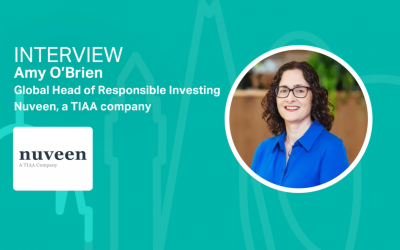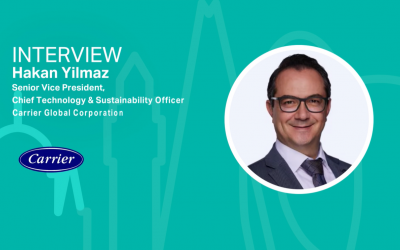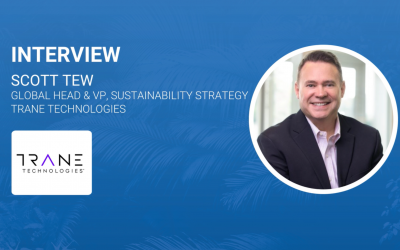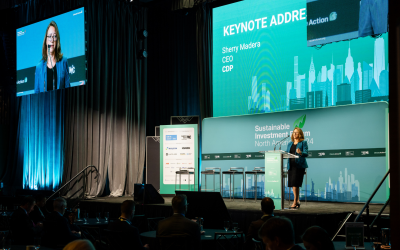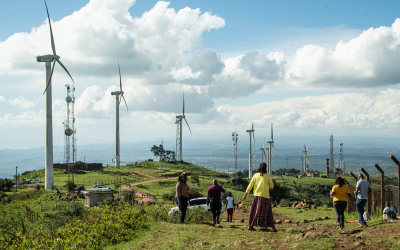Megan Kemp on the Future of Scaling High-Integrity Carbon Removals
In the lead-up to the Climate Innovation Forum at London Climate Action Week, Climate Action caught up with Megan Kemp, Global Head of Strategy, NextGen and South Pole. In this Q&A, Megan shares insights on scaling durable carbon removals, shaping emerging policy frameworks, and the critical role of corporate and government collaboration in building a credible global CDR market.
.png)
Megan Kemp is Global Head of Strategy at South Pole, having previously headed up Carbon Dioxide Removal and led the advanced buyer facility NextGen CDR. In this role Megan leads on, building innovative carbon products, scaling voluntary and compliance carbon markets, and collaborating across the CDR ecosystem to stimulate corporate and government demand before it is too late. Previously Megan has been an Engagement Manager at McKinsey & Co, driven international cooperation at No10 in the Prime Minister's Covid Implementation Unit and developed no deal policy at the Department for Exiting the European Union. She has an MBA from Harvard Business School and BA from the University of Oxford.
Can you tell us about South Pole’s current role and strategic vision in the global carbon dioxide removal (CDR) landscape?
South Pole is committed to scaling both nature-based and technological carbon removals. On the NBS side, we support project developers and investors across four continents to originate high-integrity assets and deliver credits to buyers. On the technological side, we co-founded the NextGen CDR buyers club in 2021, creating bankable, high-durability CDR portfolios that reduce risk for corporate buyers and catalyse market demand. Our broader strategy also involves advancing standards (e.g., through the SSFA Claims Guidance and CCS+), enabling informed credit portfolio strategies, and advising corporates on Oxford principles-aligned pathways to net zero. We see ourselves as both an architect and enabler of a mature, credible global CDR market.
How does South Pole navigate and influence the rapidly evolving global removals regulation environment, and how does it compare with the UK's approach?
South Pole is actively engaged in shaping emerging policy frameworks. We’re closely involved in developments under CORSIA, the EU’s CRCF, and the UK’s evolving ETS. The UK’s approach—voluntary principles now, with ETS inclusion from late 2020s, early 2030s—is cautious but credible. However, accelerating regulatory clarity is essential. We also strongly advocate with our partners (e.g., WBCSD, NEP) for creating a clear bridge between voluntary and compliance markets, driving for alignment to avoid fragmentation that would otherwise hinder corporate investment. The UK has an opportunity to lead through a high-integrity market architecture that others can emulate, and step into the gaps left by other governments short-term pull back from carbon markets. The announced allignment with the EU ETS is an excellent first step.
What are the key short-term and long-term drivers of demand for carbon removals that you're observing across corporate and government sectors?
Short-term demand on the Voluntary Carbon Market is being driven by strategic leadership, business opportunities, and preparation for future regulation. Companies are building early portfolios to secure access to high-quality supply, signal ambition, and develop in-house buying capability. Think Microsoft, SwissRe, Airbus. Longer-term (post 2030), demand will be shaped by integration of removals into compliance markets (e.g., UK ETS, EU ETS, Japan’s GX-ETS), updated corporate guidance such as SBTi V2 and ISO net zero standard, and price reductions made possible through scale and government support. Interim targets for permanent removals and clear claims guidance are essential to unlock forward-looking investment that will enable future supply to meet demand.
With increasing scrutiny in voluntary markets, how does South Pole ensure transparency and maintain high standards of quality control in its carbon credit offerings?
We consistently align with the highest-integrity carbon credit standards. South Pole has independent in-house risk and compliance functions and applies rigorous quality management processes across its entire project portfolio. Our Risk and Quality Control reviews go beyond the requirements of leading carbon standards such as Verra and Gold Standard. We also support our clients with insights to make informed decisions and manage risk across their portfolios.
For example, NextGen transacts only credits certified under ICROA-endorsed standards and actively supports the development of rigorous frameworks such as the ICVCM’s Core Carbon Principles and the EU CRCF. We also support methodological innovation through CCS+ and ensure robust due diligence on every project we work with. Buyers working with South Pole benefit from our due diligence, supply-side curation, and deep market intelligence.
Can you elaborate on the role of the NextGen CDR initiative in scaling up both supply and demand for durable carbon removals?
NextGen CDR, a joint venture between South Pole and Mitsubishi Corporation, serves as a foundational mechanism to accelerate deployment of durable tech-based carbon removals by directly addressing market barriers on both supply and demand fronts. For example:
Demand
- Diversified portfolio risk reduction. NextGen constructs a multi-technology, multi-region portfolio—from the world‑leading DACS projects (such as Summit and 1PointFive in the US), to biochar in Bolivia (Exomad) and enhanced weathering in India (Alt Carbon)—spreading delivery and technology risks.
- Target price discipline for buyers. By anchoring a benchmark price ($200/t) and offering long-term contracts, NextGen brings budget predictability and market transparency, making entry into emerging tech CDR more feasible for corporates.
- Government engagement. NextGen actively engages with governments e.g., UK, EU, Japan, Singapore, US, to shape enabling policy environments, advocating for integration of durable CDR into compliance frameworks. We also support regulatory alignment by advancing standards development and showcasing high-integrity procurement models as blueprints for public sector action.
Supply
- Long-term, credit-worthy commitment. NextGen pools demand from globally recognised buyers—LGT, UBS, Swiss Re, BCG, Mitsui O.S.K. Lines, and most recently Mizuho— to purchase long-term offtakes. This creates the bridge demand for projects where the service currently is not valued and enables projects to become bankable and attract the necessary project financing for their CapEx intensive projects.
What are some of the major challenges or gaps in the current global removals market that South Pole is working to address?
The removals market faces multiple interconnected challenges: high costs, policy fragmentation, limited corporate guidance, and trust deficits. At the heart of these is a lack of scalable, investable demand. Corporate buyers remain constrained by high average prices—over $300 per tonne for tech CDR—and the absence of clear, near-term compliance obligations. At the same time, supply is held back by the capital-intensive nature of removals projects, which require project-level debt financing that remains scarce without long-term offtake certainty.
Policy clarity is improving but still incomplete. The SBTi’s forthcoming Version 2 Corporate Net-Zero Standard—requiring interim removals targets (initially Scope 1 only)—and ISO’s upcoming Net Zero guidance are promising steps. Likewise, regional compliance signals are emerging: Singapore now allows 5% offsetting under its carbon tax, California has incorporated removals into its cap-and-trade, and both the UK and EU plan to include durable CDR in their ETS. However, these frameworks must converge more consistently if they are to send investable signals to the market.
Trust also remains a fundamental barrier. With numerous methodologies standards in play, corporates face a confusing quality landscape. Encouragingly, initiatives like the VCMI Claims Code and the EU Green Claims Directive are starting to create alignment. South Pole contributes to this by shaping credible claims guidance (e.g., SSFA), participating in methodology development (e.g., CCS+), and working with financial institutions to design structures that unlock capital.
Finally, to accelerate cost decline, governments must act decisively through mechanisms like innovation funding (EU), tax credits (US 45Q), contracts for difference (UK), and strategic procurement (Canada, US). South Pole and initiatives like NextGen play a vital role in closing the gap between early innovation and infrastructure-scale investment—creating bankable, credible pathways to scale
How is South Pole helping its clients transition from conventional offsets to more permanent, 'like-for-like' removal solutions?
We guide clients in building Oxford Offsetting Principles-aligned strategies that evolve over time—starting with high-integrity avoidance credits in the near term, and gradually increasing the share of durable, like-for-like removals in line with their net zero year. This staged approach balances climate integrity with commercial feasibility, enabling organisations to act now while preparing for long-term compliance and reputational expectations.
Our support includes portfolio design, technology and supplier due diligence, structuring long-term offtake agreements and credit procurement. By incorporating both nature-based and technological removals, and constantly re- aligning with voluntary frameworks like SBTi and emerging government standards e.g., EU CRCF, we ensure our clients’ credit portfolios are not only credible today, but future-proofed for the evolving regulatory and voluntary landscape.
Looking ahead, what is your outlook for the global carbon removals market over the next 5 to 10 years? What role will corporate actors play in this transition?
The removals market must scale from today’s modest base to around 400 Mt by 2030, and ultimately to gigatonne levels by 2050—requiring 37% annual growth. We believe this trajectory is achievable. Governments will be the key enablers, as they have been in other sectors where the solution serves as a public good, such as renewable energy. Over time, we expect a highly regulated market underpinned by robust infrastructure—insurance, ratings, data—and likely evolving into a commodities market where credits are distinguished by storage durability rather than method or co-benefits.
Corporates, however, will remain the vanguard. They are already building early demand, shaping quality expectations, and driving capital into the market. Through initiatives like NextGen, they are also helping to de-risk investments, making projects bankable and scalable. The opportunity ahead is not only to grow the market, but to shape it into one that is just, inclusive, and economically efficient—with emitters funding high-integrity removals globally. At South Pole, we are advocating for this vision, alongside partners and buyers committed to long-term climate impact.
Given your experience across government, consulting, and climate finance, how do you see multi-sector collaboration shaping the future of CDR markets?
Collaboration is not optional—it is foundational. Multi-sector partnerships are required to scale financing, harmonise standards, and reduce delivery risk. Buyers clubs like NextGen demonstrate the power of aggregated demand. Governments can de-risk investment through procurement and policy, while NGOs play a role in ensuring equity and integrity at this early stage. If we succeed in coordinating across sectors, we have the opportunity to design a just, efficient and investable market that delivers climate impact at scale.
South Pole and NextGen CDR are co-hosting a roundtable from 11:00-12:00pm on Wednesday 25th June at the Climate Innovation Forum. "Accelerating carbon dioxide removals: bridging markets and driving impact for UK corporates" will bring together leaders from government, business & finance to explore how the UK can scale high-integrity carbon dioxide removals (CDR) — both in voluntary and compliance markets. Apply to attend here.

